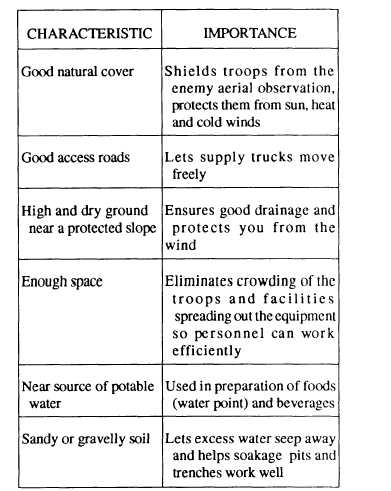| |
CHAPTER 11
FIELD KITCHENS
At some point you may be assigned to an
amphibious or naval mobile construction battalion and
accompany it ashore as a member of a landing party. A
landing party usually consists of 100 personnel and has
2 or 3 MSs assigned. As an MS, you should be prepared
to provide food for those troops you accompany. You
also will probably become involved in locating the
proper site for the field kitchen and in its construction.
This chapter will present to you the skills needed to
accomplish the following:
l
l
l
l
l
l
Select field kitchen sites
Plan a layout of field kitchen facilities
Unpack and set up kitchen tents
Unload and arrange field kitchen equipment in
the kitchen tents
Clean and reload field kitchen equipment
Pack and store field kitchen tents
FIELD KITCHEN SIGHT SELECTION
AND LAYOUT CHARACTERISTICS
Naturally, you will want the best available site for
your field kitchen. The general area in which personnel
will be fed is normally determined by the shore party
commander. You, the MS, may have to recommend the
selection of a particular site.
PLANNING THE LOCATION
There are several details to look for when you pick
a site. Figure 11-1 lists the characteristics of a good field
site. It also explains why these characteristics are
important.
Type of Terrain
If there is danger of bombing or other enemy action,
select a location that provides good natural cover and is
well shielded from observation.
High, dry ground near a slope that provides good
drainage is desirable. A good water supply should be
nearby, with an access road for kitchen traffic only, if
possible. Your galley
away from the heads.
should be at the proper distance
Figure 11-1.—Characteristics of a good field site.
Water Supply
You should regard all water in the field as
contaminated until bacterial analysis reveals it to be
potable.
It may become contaminated during
distribution and storage. Consider all untreated water
unsafe until a medical representative approves it for use.
During the initial phase of amphibious operations, each
unit may carry its own water or depend on a local supply.
The local supply of water must be disinfected and placed
in sterilized lyster bags (36-gallon canvas bag) or
canteens.
The responsibility for the adequacy and safety of
the water under these conditions normally falls largely
on the unit medical officer. However, you should be
familiar with chapter 5, “Water Supply Ashore,” of the
Manual of Naval Preventive Medicine, NAVMED
11-1
|

